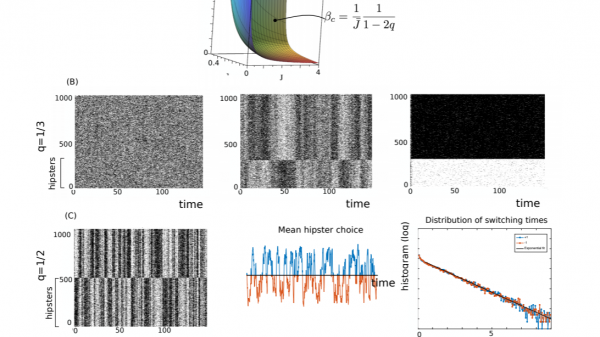Hipster effect: why nonconformists often look the same
The science of complexity explains why trying to reject what is generally accepted simply leads to new consistency.

You are probably familiar with this effect - and, perhaps, you yourself are its victim. You feel a common culture alien to yourself and you want to declare that you are not part of it. You decide to dress differently, change your hairstyle, apply unconventional makeup or care products.
And yet, when you finally open your new image to the world, it turns out that you are not alone - millions of other people made the same decisions. And you all look more or less the same, which is exactly the opposite of the countercultural statement that you tried to make.
')
This hipster effect is a counterintuitive phenomenon, as a result of which people who deny common culture begin to look the same. Similar processes occur in investors and in other areas studied by social science.
How does this synchronization happen? Is it inevitable in modern society, and is there a way to really stand out from the crowd?
Today, we will get answers through the work of Jonathan Tubula from Brande University in Massachusetts. Tubul is a mathematician who studies how information transfer in a community affects people's behavior. In particular, he concentrates on a community of conformists who replicate the majority and nonconformists , or hipsters , who try to do the opposite.
He concluded that in a fairly wide variety of scenarios, the hipster population always experiences a phase transition during which its members synchronize with each other in their opposition to generally accepted norms. In other words, the hipster effect is the inevitable result of the behavior of a large number of people.
It is important that the Tubula model takes into account the time it takes for each individual to detect changes in society and react accordingly. This delay is important. People do not react instantly to the appearance of a new, very fashionable pair of shoes. Information slowly spreads on fashion sites, word of mouth, etc. The delay in distribution among different individuals is different - some may zealously follow the advice of fashion blogs, others do not have access to them, and they have to rely on rumor.
Tubul is studying the question of under what conditions the hipsters are synchronized, and how they change depending on the propagation delay and the proportion of hipsters. To do this, he creates computer models simulating the interaction of agents, some of which follow the majority, and the other part contradicts him.
This simple model produces surprisingly complex development options. In general, as Tubul says, the hipster population initially behaves randomly, but then comes to a synchronized state through a phase transition. He discovers that this happens with a wide variety of parameters, and that this behavior can be quite complex, depending on the interaction of hipsters and conformists.
There are some unexpected results. With equal proportions of hipsters and conformists, the entire population is subject to random switching between different trends. Why is this so - is not yet clear, and Tubul plans to study this in more detail.

It can be argued that synchronization arises from the simplicity of scenarios, where a choice of two options is offered. “For example, if most individuals shave their beards, then most hipsters will want to grow them, and if this trend spreads to most of the population, this will lead to a new, synchronized transition to shaving,” said Tubul.
If there are more options, it is easy to imagine another scenario. If the hipsters, for example, could grow a mustache, a square beard or a goatee, then this variety of choices could prevent synchronization. However, Tubul discovered that if the model offers more than two choices, synchronization still happens.
And yet it is interesting to him to study it further. “We will explore this issue further in the next work,” he said.
It is easy to make fun of hipsters, but the applicability of these results is much wider. For example, they can be useful for understanding financial systems, whose members try to make money by making decisions opposite to those of most stock market participants.
Indeed, there are many areas in which the delay in the dissemination of information plays an important role. As Tubul says: “Besides the question of choosing the best clothes for the current season, this study may have important implications for understanding the synchronization of nerve cells, investment strategies, or the evolving dynamics in sociology.”
Continuation of the story from The Register magazine: hipster complaint and unexpected denouement

Usually a headline like “Hipster effect: why nonconformists often look the same” causes the effect of rolling eyes. However, the situation becomes more interesting when the hypothesis described in the article is confirmed by amusing correspondence.
In February, MIT Technology Review published a brief but informative description of 34-page work from experts from the University of Brande. The work, in fact, argued that in an attempt to make a "countercultural statement", the hipsters as a result become similar to each other. The details of an interesting model of how the casual actions of hipsters lead to a “phase transition to a synchronized state”, as well as intricate network formulas, can be found here .
The article was accompanied by a photo from the drain, where the average millenial was depicted in a tartan jacket and a round cap, or, as Getty describes it , “fashionable winter clothes”. MIT editor, Gideon Lichfield, commented on the implications of tweeting the article, calling it a “warning story”:
“We immediately received a violent email from a person who claimed that he was depicted on the photo illustration of the story. He accused us of slander, probably related to what we called his hipster, and to use his portrait without his permission. (On the history itself, he also responded not too flatteringly). "
Wow, and the words "averaged millennial" by chance are not slander? Our magazine can’t allow anyone to sue it because of this article.
Lichfield continued the story:
“As far as I know, to call a person a“ hipster ”does not mean to slander him, regardless of the level of his hatred for it. However, we would not use the image without the appropriate rights. It was a stock photo from Getty Images, and we checked her license. ”
He said that the license indicated that if the image is used “in connection with an unflattering or too controversial topic (such as, for example, sexually transmitted diseases),” it is necessary to indicate that there is a model in the photo.
Litchfield indicated that he didn’t think it would be “unflattering or too controversial” to call someone a hipster, but I got in touch with Getty.
The stock giant contacted the model, and it turned out that the friend in the photo was not the person who complained to the publication. “He just confused himself with another,” said Lichfield.
“Everything that happened only proves our history: hipsters are so similar to each other that they cannot even distinguish themselves from others.”
Like this. 34 pages of the theory were proved in brief correspondence by email. Your turn, hipsters.
Source: https://habr.com/ru/post/444374/
All Articles